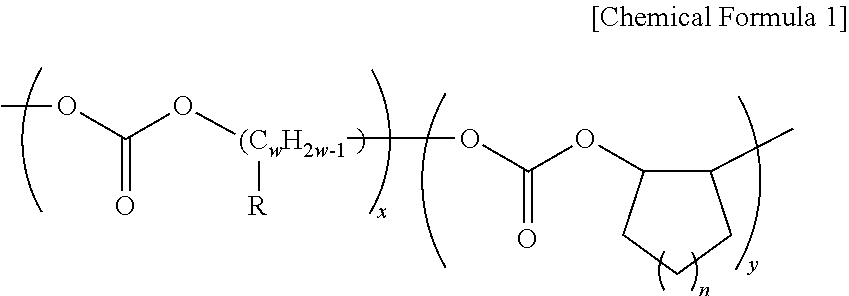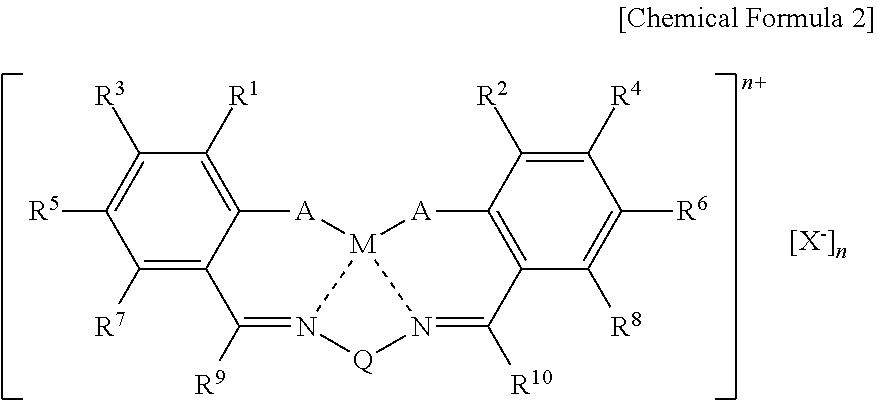Polyalkylene carbonate resin composition having an interpenetrating crosslinked structure
a technology of polyalkylene carbonate and crosslinked structure, which is applied in the field of polyalkylene carbonate resin compositions having an interpenetrating crosslinked structure, can solve the problems of weak heat resistance, small elasticity, and fragile thin film products, and achieves improved heat resistance and chemical resistance, the effect of maximizing physical properties
- Summary
- Abstract
- Description
- Claims
- Application Information
AI Technical Summary
Benefits of technology
Problems solved by technology
Method used
Image
Examples
examples 1 to 8
[0077]Polypropylene carbonate (PPC) having a weight average molecular weight of 89,000 and an ether linkage of 0.5% or less, polyester diol (U1420, Union Chemicals, Mw: 2,000) and polycarbonate diol (PCDL, G3452, Asahi KASEI Co., Mw: 2,000) were used by the amounts (by parts per weight) as illustrated in the following Table 1 to prepare resin compositions having IPN structures in accordance with example embodiments. The curing was conducted by using H12MDI (4,4′-dicyclohexyl-methane diisocyanate). Tg, Tm, strain at break and % strain at break of samples were measured by means of a Universal Test Machine (UTM), and the results are illustrated in Table 2.
[0078]
TABLE 1Polyurethane(PU)-IPN mixing ratioDivisionSample namePPCDiolH12MDIDBTDLExample 1Ester PU 2080202.7460.0263Example 2Ester PU 3070304.0450.0389Example 3Ester PU 7030709.2430.089Example 4Ester PU 8020809.2430.101Example 5PCDL PU 2080202.7460.0263Example 6PCDL PU 3070304.0450.0389Example 7PCDL PU 7030709.2430.089Example 8PCDL ...
examples 9 to 12
[0080]Polypropylene carbonate (PPC) having a weight average molecular weight of 89,000, an ether linkage of 0.5% or less, an epoxy compound (KUKDO Chemical Co., Ltd., YD-128) and a polyamide-based curing agent (KUKDO Chemical Co., Ltd., G-640) were added by the amounts as illustrated in the following Table 3 to prepare resin compositions having the IPN structure in accordance with example embodiments. The adhesion strengths of the resin compositions were measured by measuring lap shear strength using UTM apparatus. As a substrate, polycarbonate was used, and two substrates having a certain size (1 inch×4 inch×0.5 mm=length×width×thickness) based on ASTM D 5868-01 standard were overlapped by 1 inch×1 inch area. Then, an adhesive material was coated between the overlapped sides, and the adhesive force was measured after one week. The adhesion force was measured at room temperature and at 70° C. Before measuring the adhesion force, the samples were put at 70° C. for 2 hours by using th...
examples 13 to 16
[0083]Polypropylene carbonate (PPC) having a weight average molecular weight of 89,000 and an ether linkage of 0.5% or less, an acryl compound (MMA, DAEJUNG Chemicals) and 2,2-azobis-isobutyronitrile (AIBN, DAEJUNG Chemicals) as a reaction initiator were added, and a reaction restraining agent of 4-methoxyphenol (Mph, Junsei Chemical) was used. The thus obtained solution was coated on a PET film by 5-100 mm / sec rate to a uniform thickness of 5-7 lam. The coated film was stood at room temperature for 30 minutes and dried at 70° C. condition, and surface hardness was measured. The surface hardness was measured by using a pencil hardness measuring apparatus (COAD606, OCEAN SCIENCE).
[0084]
TABLE 5Acryl-IPN mixing ratioReactionrestrainingDivisionSample namePPCMMAInitiatoragentExample 13Acryl 20802010.1Example 14Acryl 3070301.50.15Example 15Acryl 7030703.50.35Example 16Acryl 80208040.4ComparativePPC100000Example 3
[0085]
TABLE 6Hardness measured resultsDivisionHardness (H)Example 132Example ...
PUM
| Property | Measurement | Unit |
|---|---|---|
| Tg | aaaaa | aaaaa |
| Tg | aaaaa | aaaaa |
| length×width×thickness | aaaaa | aaaaa |
Abstract
Description
Claims
Application Information
 Login to View More
Login to View More - R&D
- Intellectual Property
- Life Sciences
- Materials
- Tech Scout
- Unparalleled Data Quality
- Higher Quality Content
- 60% Fewer Hallucinations
Browse by: Latest US Patents, China's latest patents, Technical Efficacy Thesaurus, Application Domain, Technology Topic, Popular Technical Reports.
© 2025 PatSnap. All rights reserved.Legal|Privacy policy|Modern Slavery Act Transparency Statement|Sitemap|About US| Contact US: help@patsnap.com



